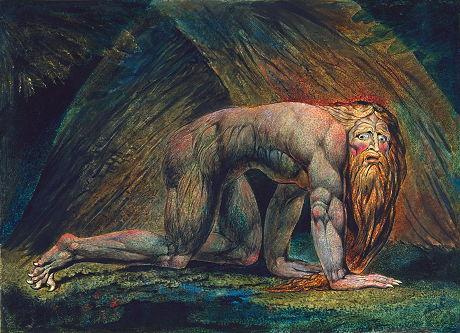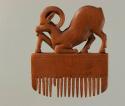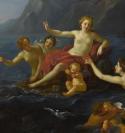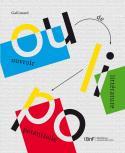Art Of The Day Weekly
#367 - from 4 December 2014 to 10 December 2014

William Blake, Nebuchadnezzar, 1795–c. 1805, medium colour print, ink and watercolour on paper, 543 x 725 mm, Tate.
IN THE AIR
Blake, the visionary
OXFORD - The charge of great British artists continues. After Turner and Constable, two perfect contemporaries were in the limelight in London, it is now the turn of William Blake, a few years older than them (1757-1827), who is celebrated in Oxford. The exhibition retraces the itinerary that saw this artist of the bizarre take shape: his training at an engraver's, the hours spent in the medieval London churches (which would leave a mark on him for quite some time), then his productivity of dreamlike images, helped by an enlightened publisher, Joseph Johnson. His work, inspired by the Antiquity, mythology and the gothic novel of his time, is peopled by disquieting, nightmarish figures, accompanied by poems and prophecies which years later would delight the Surrealists. One of the major works in the presentation is the reconstitution of his London workshop. The building that housed it on Hercules Road, in Lambeth, was demolished in 1918. It was frustrating not to be able to understand how it was arranged until the very recent discovery of the plans. Blake the unclassifiable is more alive than ever…
• William Blake at the Ashmolean Museum, from 4 December 2014 to 1 March 2015.
EXHIBITIONS
Fairytales are for ever modern
EVIAN - Cinderella, Tom Thumb, Sleeping Beauty as well as a less pleasant series, Blue Beard or teh wolf who gobbled up Little Red Riding Hood… Fairytales accompanied us all throughout our childhoods. But who remembers that in the beginning their public were the adults on the village squares? Stories not only belong to the enchanted world, but they are also allegories of life, and they can be interpreted in various manners (mong them by psychoanalisis, as by Bruno Bettelheim). Actually adults never cease to be interested in fairytales, whether as consumers or as producers, as this exhibit shows us. It combines works from the past (a mean ogre by Gustave Doré or a gentle Peau d’âne, by Jean-Antoine Laurent in 1819), from the 20th century (the decors by Jean-Denis Masclès for the ballet Cinderella by Frederick Ashton on the music by Prokofiev in London in 1948) or more contemporary. Jim Dine, 80 years old, has been obsessed for 75 years by Pinocchio, and he has produced him a number of times. And young generations, like Katia Bourdarel or Guillaume Baychelier, continue the tendency. Hansel and Gretel are surely not "passé": their last avatar is in the form of a video.
• Contes de fées at the Palais Lumière, from 6 December 2014 to 6 April 2015.
Bon Boullogne, portrait of an unknown man
DIJON – At the time of Louis XIV, historic paintings were a big success, especially by the highly powerful Le Brun. At the end of his reign ther was a whole squadron of new painters, which Jouvenet and Antoine Coypel belonged to. One of the ones who is the least documented in the group is Bon Boullogne (1649-1717). And yet we owe him the systematic use of mythologic nudes, that would nourish a blooming school at the beginning of the 18th century. This retrospective updates us on this relatively rare painter, based on some thirty paintings identified in France.
• Bon Boullogne, un chef d’école au Grand Siècle at the musée Magnin, from 5 December 2014 to 5 March 2015.f

Comb : kneeling ibex. New Empire, 18th dynasty (1550-1425 BC) © Musée du Louvre, Dist. RMN-GP / Christian Decamps
On the banks of the Nile
LENS - Cats, ibis, crocodiles, scarabs: these are the animals we all think of automatically whenwe talk about the time of the Pharaohs. But the Egyptian bestiary from that time is much larger as this retrospective proves by showing the collections from the Louvre. Frog, scorpion from the Sahara, sea urchins or balloon-fish are also part of the chosen few, used for pharmacopea, offerings, or as companions in this life or in the beyond…
• Des animaux et des pharaons, at the Louvre Lens, from 5 December 2014 to 9 March 2015.
AUCTIONS

Lot 44. Exceptional anthropomorphous Dan spoon, Ivory Coast. 62 cm tall. Estimate: €100 000 – €150 000
Spoon it up!
PARIS – Ernesto Wolf (1918-2003), a Brasilian industrialist who fled Nazi Germany when he was a child, and his wife Liuba (1923-2005) were compulsive collectors. We have already mentioned them earlier, about a sale in December 2012 at Artcurial. Aside from their remarkable collection of medieval glasses, which they donated to the museum of Stuttgart, their treasures, ranging from illuminated manuscripts to works by Basquiat from the 1980s, required various auctions spaning a certain period of time. After modern art a bit earlier this month, here we have a tribal parenthesis. It brings together 126 objects, all of the same nature: spoons, sculpted over the centuries by African artisans. From the Bidjogo in Guinée-Bissau to the Senoufo in the Ivory Coast, from the Ashanti in Ghana to the Zulus in South Africa, they cover practically the whole continent, including Liberia and ancient Somalia. They are generally in wood, sometimes in metal, bone or even in ivory, they have nothing to do with our commun everyday instrument but are more often ceremonial objects. The most beautiful piece is a Dan, anthropomorphous spoon estimated between €100 000 and €150 000, that represented the favorite wife of the chief and could be dressed and made up like a doll…
• Art tribal : la collection Ernesto et Liuba Wolf on 10 December 2014 chez Artcurial
ARTIST OF THE WEEK
Cruz-Diez, the pope of kinetics
Born in 1923, he is one of the greatest names in Cinetic and optic art. Yet, in a first life in Venezuela, his native country, he was a figurative painter, committed to social struggle, until he realized his art would never have the power to change the world. At the beginning of the sixties, following a trip through Spain, he headed for Paris, where he found in particular his great childhood friend and compatriot, Soto. Over the next fifty years he constantly worked at colors, combining them, adding, saturating them, creating chromatic induction showers or "colorful traps". He also designed colossal urban installations, many of them in Venezuela but also in Europe (at the station of Saint-Quentin-en-Yvelines or at the Zurich headquarters of the Union des banques suisses). At the age of 91, this friend of Vasarely and Julio Le Parc is as active as ever, as he supervises a team of 60 persons between Paris and Panama, which has nothing to envy to the teams of Koons or Hirst…
• Cruz-Diez en noir et blanc at la Maison de l’Amérique latine, until 31 January 2015.
• Color espacial at the Centro Niemeyer in Avilés (Spain), until 8 February 2015
BOOKS
Oulipo is for real
Oulipo as well as Ouhispo, Ouphopo, Oucuipo, Oupolpot… These are not names of African rivers but rather of the Ouvroir de littérature potentielle,(the Workshop of potential literature) founded by Raymond Queneau and François Le Lionnais in 1960, and all its emanations (History workshops, photography workshops, kitchen workshops, potential political workshops). At the beginning there was a wish to produce a complicated literature (or rather magnified) through a series of mathematical constraints – using the number of syllables, the repetition of letters or their absence such as the famous Disparition by Georges Pérec, a complete book without the letter "e". This book is the catalogue of an exhibition at the library of the Arsenal, Paris, until 15 February 2015. It brings back to life a current adventure halfway between a club of crossword puzzles and an esoteric sect, with more influence than we can imagine.
• Oulipo, collective work, Gallimard, 2014, 192 p., €39.
OPENINGS OF THE WEEK
6 December 2014 - PARIS - Galerie Patricia Dorfmann
The conceptual corpus of a Danish artist, inspired by the Internationale situationniste
IN BRIEF
LONDON - The Irish artist Duncan Campbell was awarded the 2014 Turner Prize.
MIAMI - The modern and contemporary art fair Art Basel Miami Beach will be held from 4 to 7 December 2014.
TORINO - Galleria Sabauda, the collection of ancient masters, which moved to give space to the Museo Egizio, will open again to the public at the Palazzo Reale on 4 December 2014.



